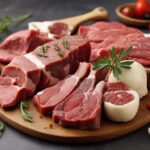In the world of gastronomy, the quality of ingredients is a determining factor in achieving exceptional culinary results. When it comes to meat, choosing the highest quality cuts is essential to elevate your dishes from ordinary to extraordinary. In this article, we will explore in detail how to select quality meat, from its origin on the farm to its arrival at your table. Discover the essential criteria you should consider when purchasing meat to ensure an unparalleled gastronomic experience. Keep reading to uncover the secrets of selecting top-notch meat!
Origin and Rearing of Meat: A Key Piece in its Quality
The process of rearing and the origin of meat play a crucial role in its final quality. It is essential to understand how animals are raised and where the cuts that reach our table are produced to guarantee an exceptional culinary experience.
Ethical and Sustainable Farming
The quality of meat begins on the farm. Opt for producers who practice ethical and sustainable farming methods. Animals raised on pasture and fed a natural diet tend to produce tastier and more nutritious meat. Furthermore, these environmentally friendly practices also contribute to the overall quality of the product.
Feeding and Care
The diet and care animals receive during their upbringing have a direct impact on the quality of meat. Animals fed a balanced and natural diet, free from additives and hormones, typically produce higher quality meat. Additionally, access to clean water and a healthy environment also influences meat development.
Quality Control in Production
It is important for producers to implement strict quality controls at all stages of meat production. This includes monitoring animal health, hygiene in facilities, and compliance with sanitary standards. Meat produced under high-quality practices tends to be safer and fresher for human consumption.
Transparency in the Supply Chain
Consumers increasingly value transparency in the food supply chain. Look for producers and suppliers that provide detailed information about the origin of the meat, rearing conditions, and production methods. This will allow you to make informed decisions and select the highest quality meat.
Selecting ethically and sustainably sourced meat not only ensures a superior quality product but also promotes more responsible and environmentally friendly food practices. By understanding and valuing the meat production process, we can enjoy a more rewarding and conscious culinary experience.
Visual Aspect of Meat: How to Identify Quality by Sight
The visual aspect of meat is one of the first indicators of its quality and freshness. Learning to visually assess meat cuts will help you select the highest quality products for your culinary recipes. Here are some aspects to consider:
Fresh and Uniform Color
Quality meat typically has a fresh and uniform color. Look for cuts that have a bright red hue for beef, pale pink for pork, and light pink for chicken. Avoid areas with discoloration or gray tones, as they may be indicative of deterioration.
Moderate Marbling
Marbling refers to the distribution of fat within the muscle tissue of the meat. Look for cuts with moderate marbling, meaning fine veins of fat that are evenly distributed. This marbling contributes to the juiciness and flavor of the meat when cooked.
Firm and Elastic Texture
When lightly pressing the meat with your fingers, it should quickly regain its shape. A firm and elastic texture indicates freshness and quality. Avoid meat that feels soft or slimy, as it could be a sign of decomposition.
Absence of Secretions
Check for any liquid secretions on the surface of the meat. The presence of viscous liquid or blood stains may indicate that the meat has been stored for too long or has not been handled properly.
By paying attention to the visual aspect of meat, you’ll be able to select superior quality cuts for your culinary preparations. Remember that freshness and appearance are important indicators of quality and food safety.
Scent and Freshness of Meat: Quality Indicators You Should Know
Scent and freshness are two crucial aspects when selecting quality meat for your dishes. A fresh and pleasant aroma is an indicator that the meat is in optimal condition, while any unpleasant odor may signal deterioration. Here’s how to evaluate the scent and freshness of meat:
Fresh and Natural Odor
As you approach the meat, take a deep breath and pay attention to the aroma. Fresh meat should have a mild and natural scent, without any hints of rot or rancidity. Trust your instincts: if you detect any unpleasant odor, it’s best to avoid that cut.
Absence of Unpleasant Odors
Avoid any meat that has a sour, metallic, or chemical odor. These smells may indicate that the meat has started to decompose or has been treated with chemicals. Always opt for cuts that emit a fresh and clean aroma.
Freshness on the Surface
Inspect the surface of the meat and check for signs of decomposition, such as dried blood stains or viscous liquids. Fresh meat should have a clean surface without traces of excessive moisture.
Moist and Juicy Texture
When touching the meat, notice if the surface is moist but not sticky. Fresh meat often has a smooth and slightly moist texture to the touch. Avoid any meat that feels slimy or slippery, as it could be a sign of decomposition or bacterial contamination.
Expiration Date and Storage
Always check the expiration date and verify the storage conditions of the meat. Make sure to select cuts that are within their expiration date and have been properly stored in refrigeration or freezing to maintain their freshness.
By paying attention to the scent and freshness of the meat, you can ensure that you are selecting products of the highest quality for your meals. Remember that food safety is paramount, so trust your senses and always opt for fresh and well-preserved meat.
Labeling and Certifications: Quality Assurance in Meat
When purchasing meat, it’s crucial to pay attention to the labeling and certifications accompanying the product. These labels and seals provide important information about the origin, quality, and production methods of the meat. Here’s how to interpret the labeling and what certifications to look for:
Origin and Production Process
Labels often provide details about the origin of the meat and how it has been produced. Look for information about the country of origin, the producer’s name or brand, as well as details about the rearing and processing methods used.
Organic Certifications
Organic certification seals indicate that the meat has been produced following specific organic farming standards. These standards typically include the prohibition of pesticides, herbicides, and synthetic fertilizers, as well as the promotion of more ethical and sustainable animal farming practices.
Hormone-Free and Antibiotic-Free
Some labels indicate that the meat is hormone-free or antibiotic-free. These seals ensure that animals have not been treated with growth hormones or antibiotics during their upbringing, which can be important for those who prefer to avoid these additives in their diet.
Animal Welfare
Some certifications focus on animal welfare, ensuring that animals have been raised in conditions that respect their natural health and behavior. These seals may indicate that animals have access to pasture, adequate space to move around, and are free from excessive confinement.
Environmental Sustainability
Some labels highlight the producer’s commitment to environmental sustainability, indicating farming and production practices that minimize negative impacts on the environment. These seals may include certifications related to sustainable management of natural resources and reducing carbon footprint.
When seeking quality meat, check the labels and certifications to ensure you’re selecting products that meet your standards of quality, ethics, and sustainability. These indicators provide additional assurance that you’re purchasing fresh, safe meat produced responsibly.
Questions for the Butcher: Leveraging Their Expertise to Choose the Best Meat
When you’re at the butcher shop, don’t hesitate to leverage the butcher’s knowledge and experience to select the highest quality meat cuts. Butchers are trained to provide detailed information about products and can assist you in making informed decisions. Here are some key questions you can ask the butcher:
Origin and Provenance
Inquire with the butcher about the origin of the meat and how it has been produced. Where does the meat come from? Has it been raised organically or conventionally? Knowing the meat’s origin will help you assess its quality and freshness.
Cuts and Preparation
Seek recommendations from the butcher on the best cuts for your culinary needs. What is the most suitable cut for grilling? Which cuts are ideal for stewing or slow cooking? The butcher can offer helpful advice on meat preparation and cooking.
Freshness and Storage
Find out how long the meat has been on display and how it has been stored. When did the meat arrive at the store? Has it been properly refrigerated? It’s important to select fresh and well-preserved meat to ensure its quality and food safety.
Custom Cutting
If you need a specific cut or a certain amount of meat, ask the butcher if they can cut it to your preferences. Many butcher shops offer custom cutting services to meet individual customer needs.
Preparation and Cooking Tips
Take advantage of the butcher’s experience to get advice on meat preparation and cooking. What is the best way to season this cut? What is the recommended cooking time to achieve the perfect doneness? The butcher can provide you with specific recommendations based on their experience.
By asking questions to the butcher, you’ll be able to make more informed decisions and select the highest quality meat cuts for your recipes. Don’t hesitate to leverage their experience and knowledge to ensure a satisfying culinary experience.
Conclusion: The Art of Selecting Quality Meat
Selecting quality meat is an invaluable skill in the world of cooking. From the farm to the table, every step in the production process influences the freshness, flavor, and quality of the meat that ends up on our plates. By paying attention to aspects such as origin, visual appearance, smell, labeling, and advice from the butcher, we can ensure an exceptional culinary experience.
It’s important to remember that the quality of meat not only translates to better taste but also to health and well-being benefits. Opting for ethically raised, sustainable, and additive-free meat is a conscious choice that benefits both our palate and the environment.
At the end of the day, choosing the right meat is a combination of knowledge, experience, and confidence. Don’t hesitate to ask questions, explore options, and try different cuts to discover your favorites. With a little attention and care, you can transform your homemade dishes into true gastronomic masterpieces.
Enjoy your next culinary adventure, selecting the highest quality meat to delight your guests and satisfy your own discerning palate!
More content
- Gastronomía egipcia: dieta y recetas ancestrales

- Comida Callejera en el Mundo: Historia y Platos Típicos

- Historia del Chocolate: De los Aztecas al Presente

- Culinary Globalization: Exploring 6 Iconic World Dishes

- Sustainable Dishes: Gastronomic Trends for a Greener Future

- The Most Impactful Gastronomic Trends Shaping the World

- Myths and Legends: The Magical Stories Behind Foods

- Symbolism of Food: The Meaning in Every Bite

- Iconic Dishes of Spanish Cuisine by Region

- Exploring Flavors: Top 10 Typical Dishes of Latin America

- Perfect Pairing: Wines and Dishes for Gastronomic Celebrations

- Title: Culinary Traditions in Festivals: Festive Flavors of the World

- Gastronomy and Folklore: Culinary Traditions and Local Myths

- Culinary Journey: Discovering Culinary Traditions from Different Cultures

- Healthy and Affordable Recipes: Eating Well Without Spending Much

- Healthy Breakfasts: 7 Nutritious Recipes for the Whole Week

- Probiotic Foods: How Do They Improve Your Digestive Health?

- Boost Your Immune System: The Best 10 Foods

- 6 Healthy Recipes for a Balanced and Delicious Diet

- 15 Foods to Maintain a Balanced and Nutritious Diet

- Menus for Allergen-Free Diets: The Best Recipes and Nutritional Strategies

- Dietary Plans for Food Allergies: Top 10 Tips and Recommendations

- Low-Carb Diets: Top 10 Recommended Foods

- Low-Carb Diet: A Beginner’s Guide

- Easy Gluten-Free Recipes for Every Day of the Week

- Complete Guide to Gluten-Free Diets: Tips for Beginners

- Protein Sources in a Vegan Diet: What to Do?

- Vegetarianism for Beginners: Simple Steps to Adopt This Lifestyle

- Taste the Best of Africa: Top 5 Iconic Regional Recipes

- The Secrets of African Cuisine: Traditional Recipes and Flavors

- 10 Latin American Sweets: Tempting Dessert Adventures Await

- Secrets of Latin American Cuisine: Traditional and Authentic Recipes You Must Try

- Taste of the Mediterranean: 5 Key Dishes

- Simple Mediterranean Cooking for Beginners: Impress Your Guests!

- Homemade Sushi: Simple Steps to Prepare Your Favorite Rolls

- Secrets of Asian Cuisine: Discovering 8 Traditional Techniques

- Innovation in Cuisine: Gourmet Products in Traditional Recipes

- The 10 Most Exclusive Gourmet Products You Must Try

- White Fish vs. Blue Fish: Which is Better for Your Health?

- The Secrets of Perfect Seafood Cooking: Kitchen Tricks

- How to Choose the Best Poultry for Your Recipes

- From Farm to Table: How to Select Quality Meat

- Complete Guide: Enhance Your Dishes with Fresh Herbs

- Revealing the Superfood Potential of Red Fruits: Benefits & Recipes

- Starting Out in the Kitchen: Pro Chef Tips for Beginners

- Unlock Your Culinary Potential: Beginner’s Guide to Essential Techniques

- Culinary Secrets Unveiled: Elevate Your Cooking with Simple Ingredient Tricks

- Master Your Kitchen: 10 Unexpected Tips for Easy Cooking

- Art of Fruit and Vegetable Cutting: Expert Techniques Revealed

- Efficiency Unleashed: Explore the Art of Mise en Place

- Mastering Healthy Cooking: Unveiling 4 Low-Fat Secrets

- Complete Guide to Cooking Methods: Everything You Need to Know

- From Fusion to Tradition: 4 Global Gastronomic Trends

- Culinary Innovations: The Most Impactful Gastronomic Trends

- A Gastronomic Journey: Migratory Influences in the Cuisine

- Flavors of the World: A Journey Through Diverse Culinary Influences

- The Evolution of Food: Traditional vs. Modern Cuisine Compared

- The Great Masters of Cuisine: Contributions to its Evolution

- Spices Through Time: Understanding Their Historical Importance

- 5 Great Gastronomic Moments: Historic Milestones in the Cuisine


